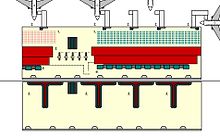Airport terminal


In air traffic, an airport terminal , also known as a check-in building or hall , is the area of the airport in which passenger traffic is handled, the reception building .
structure
The terminal is divided into a “landside” area and an “airside” area. The land side includes all publicly accessible access roads and roads as well as the main hall with ticket counters and check-in . Often there are also numerous service facilities such as banks, restaurants and rental companies, and at large airports there are even medical centers, conference rooms or an airport hotel. In some places this landside area has grown into a huge shopping and service center, which is often larger than the terminal itself.
Visitors accompanying departing passengers or picking up arriving passengers must also wait on the land side until the passenger has passed the security check. When you pass the security check, you enter or leave the "airside" of the terminal. Here the departing guest will find the shops for duty-free shopping (" duty-free shops") as well as other service facilities that are suitable for shortening the waiting time for passengers to call for their flight. Normally, you enter the aircraft almost at the same height via a passenger boarding bridge. With large aircraft, two (with the Airbus A380 : three) fingers can also be used at the same time to speed up boarding - provided the terminal is structurally prepared for such large aircraft.
Large airports often cannot handle all aircraft directly at the terminal. In such cases there are satellite buildings (the term terminal would be incorrect here) to which passengers are brought by means of a people mover . Here you will find all the airside service facilities of a departure terminal including the passenger boarding bridges , but no arrival area and no land side, as the satellite can only be reached by checked-in passengers.
Airports that do not have passenger boarding bridges take passengers by bus from the terminal to the appropriate aircraft, which the passengers then have to climb via stairs. The same applies to aircraft that have not been parked either at the terminal or the satellite, but in a free parking area on the apron.
Incoming passengers are brought to the terminal in the opposite direction via the passenger boarding bridge, the people mover or by bus transfer, where they (for international flights) are first directed to immigration control and then to the arrivals area. The flight luggage of all travelers is delivered there on conveyor belts. After the passenger has lifted his or her baggage item from the conveyor belt, he goes through the customs control through a security gate back to the land side and to the exit.
Occasionally the term freight terminal is also used for the buildings for handling air freight or the entire loading area.
Air freight terminals
Air cargo terminals are essentially divided into four types.
The Shed Terminals mainly handle air replacement traffic (LEV). They have a low throughput of less than 75,000 tons and process the inbound and outbound flows of goods in the same area. The machines used are geared towards high flexibility.
The station terminals are located on the airfield with direct access to the apron, they have an average handling capacity of between 75,000 and 250,000 tons. They achieve a good degree of utilization through high flow and some have permanently installed conveyor systems to the warehouse.
In center terminals there is a very large transfer share of well over 50 percent. Its handling capacity is between 250,000 and 1 million tons. Separate inbound and outbound flows of goods are set up for this purpose.
The hub terminals have a very high throughput of over 1 million tons. There is a very high level of automation, which enables the loading units to stay in the terminal for a minimum of time. Hub terminals are characterized by the great importance of sorting systems.

